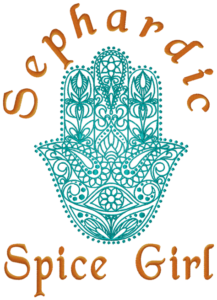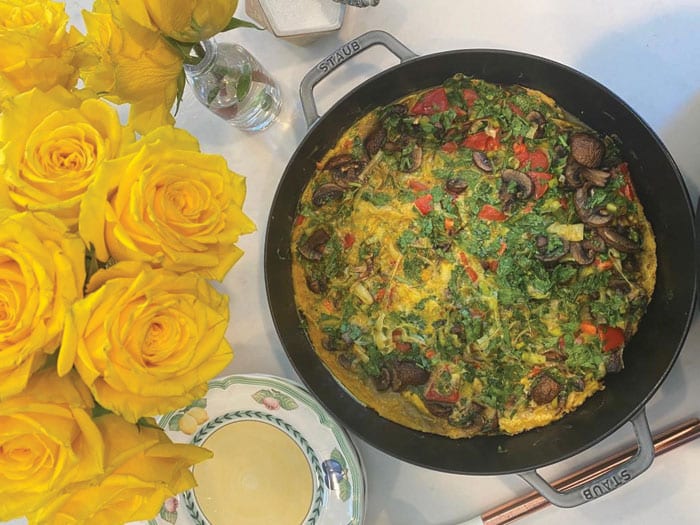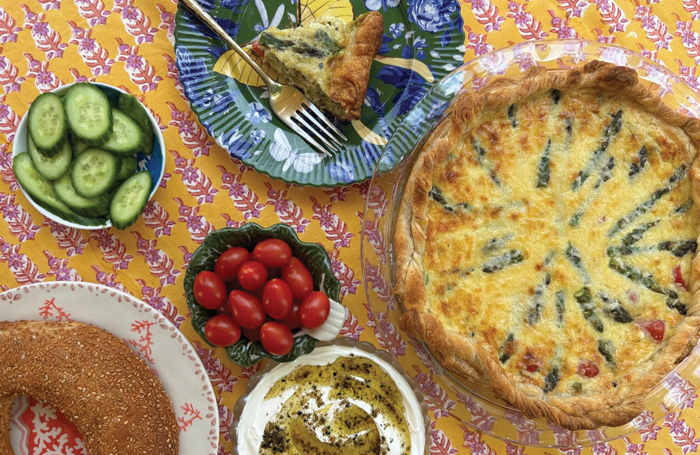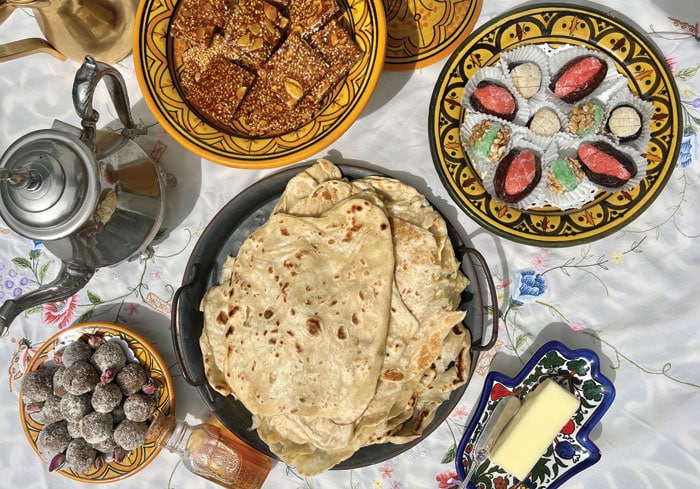Tea With Claudia Roden
As soon as she opened the door and greeted us, I was enamored. She was the sweetest, most hospitable little lady

Life is a fascinating journey, with interesting twists and coincidental turns along the way.
You may remember that Neil and I recently traveled to Madrid to visit our daughter Rebekah, who was studying on a semester abroad program. On our way home from Spain and Portugal, we stopped in London for a few days. When we booked our tickets, we had no idea that it would be “Coronation” weekend. Luckily for us, we were able to make all our hotel, dinner and afternoon tea reservations ahead of time with a little help from our friends, both here and in London.
In 1997, the Sephardic Educational Center hosted the famous cookbook author Claudia Roden. At the Sephardic Temple Tiffereth Israel in Westwood, this larger-than-life lady gave a fascinating lecture about her Egyptian roots and her world travels. She had just released her bestseller, “The Book of Jewish Food: An Odyssey from Samarkand to New York.” In this incredible book, Claudia traces the development of both Ashkenazic and Sephardic Jewish communities and their cuisine over the centuries. And there are over 800 recipes in the book! I was thrilled when she kindly signed it for me.
At the time, I was a young mother with two children and a full-time job. I was just starting to collect cookbooks and this was perhaps my first “Sephardic Cookbook.” I grew up in a home where no recipes were written down and that was probably to my advantage as it taught me to cook by “eye.” It gave me confidence in the kitchen, but I was ready to explore other cultures and cuisines. I needed some guidance.
That evening at the lecture, I fell in love with Claudia Roden and soon her massive book became my cooking bible.
That evening at the lecture, I fell in love with Claudia Roden and soon her massive book became my cooking bible.
As I read through her recipes, I thought to myself — wow, what a dream to be able to travel the world, interview people, eat in their homes, and write about it. I enrolled in a wonderful course “How to Write a Cookbook” at UCLA Extension. Writing recipes and hopefully a cookbook is a dream that I’ve been chasing for almost three decades.
Before leaving for our trip, I decided to call Freda Nessim, who in partnership with her late husband, Dr. Jose Nessim, was the original founder of the Sephardic Educational Center. Freda and Claudia Roden are first cousins and I asked her if she would be kind enough to put me in touch with Claudia.
Freda made it happen. Soon, Claudia and I were emailing back and forth, trying to arrange a time to meet on our short stopover in London. Sunday was out of the question because she would be celebrating the Coronation at the street party in her neighborhood. We finally settled on Friday afternoon (Shabbat starts very late in London in the summer months) and she kindly invited Neil and I to tea at her home near Golders Green.
Friday began with a tour of the fascinating and majestic Windsor Castle (a kind treat from an English client of Neil’s). We walked around the small town surrounding the castle, looking for flowers I could take to Claudia. Luckily, there was a small farmers market and I purchased a very English bouquet of wild flowers.
Claudia gave us detailed instructions on how to find her home: go to the end of the cul-de-sac, look for the forestry path between the two homes and her door would be at the end. The street was lovely with lots of rose bushes and beautiful trees. I was a bit nervous to meet someone I had admired for years and had inspired me on my gastronomical journey. But as soon as she opened the door and greeted us, I was enamored. She was the sweetest, most hospitable little lady.
She told us that she has three kids and when they all moved away from home, she found herself alone and bored. She decided to travel the world and research food. On her travels, she started to document recipes. She was invited into many homes, made many friends and formed lifelong friendships.
She first traveled to Morocco and became close to a French Moroccan family from Marrakech (she still keeps in touch with them).
I told her that my Spanish Moroccan family never really cooked with hot spices or chilis. She told me that it is the same for the French Moroccans and that this trend to make spicy fish and very spicy sauces is something new. That true Moroccan cuisine was never really very spicy. The same goes for Spanish cuisine — they don’t use hot paprika, rather they use sweet or smoked paprika. She told us about her recent discovery of “rose harissa” in Israel. She introduced it to food entrepreneurs in London and they made it so popular that it can be found on Amazon.
Neil asked if Julia Child was popular in England and if they had ever met, since they were both exploring food at the same time. Claudia told us that she had visited Julia’s home and even went on a picnic with her and other friends. Julia had cooked for the picnic but the dish didn’t come out so well. She told us that Julia was never really a hit with the English public. She was too messy and clumsy and they weren’t impressed by her.
After writing many books, Claudia decided to change publishers because her editors weren’t encouraging her to do more. They were just selling her published work. But Claudia wasn’t ready to stop. Claudia told us she started working with Julia Child’s editor, Judith Jones. Jones edited “The Book of Jewish Food,” which won eight international awards including the James Beard Best Cookbook of the Year in 1997.
In 2010, The Book of Middle Eastern Food was inducted into the James Beard Hall of Fame for the influence it had on food in the United States. James Beard became a dear friend. They traveled together and he connected her to many chefs and families around the world who helped with her research.
Nowadays, Claudia finds it hard to travel, but she keeps busy. Her daughter and grandchildren help with zooms and podcasts. She is still testing out recipes in her kitchen.
For tea, she served us delicious toasts with smoked salmon and red wine pickled herring, as well as with macerated strawberries and clotted cream. The day we visited, she tested a couple of recipes — one was phyllo fingers stuffed with semolina, pistachios and sugar, and another stuffed with corn flour. Ever the perfectionist, she was not happy with the results and decided they needed more work. Instead, she shared a recipe for her mother’s almond phyllo fingers.
We sat at her kitchen table and talked for hours. Neil and I felt bad that we had taken up enough of her time but she wouldn’t let us go, she wanted us to tell her about Los Angeles and Freda and the family. We stayed another hour. It was like visiting a beloved aunt.
Before we left, she showed us her beautiful English garden and we took some photos. She told us that she enjoys having friends over for dinner and that she has become very close to two famous chefs, Yotam Ottolenghi and Nigella Lawson. She even hosts them for Shabbat dinners.
As she walked us out to our Uber, she confided that she is thinking of moving closer to her kids. But she is definitely still working on the next new recipe and food discovery.
What an enchanted afternoon.
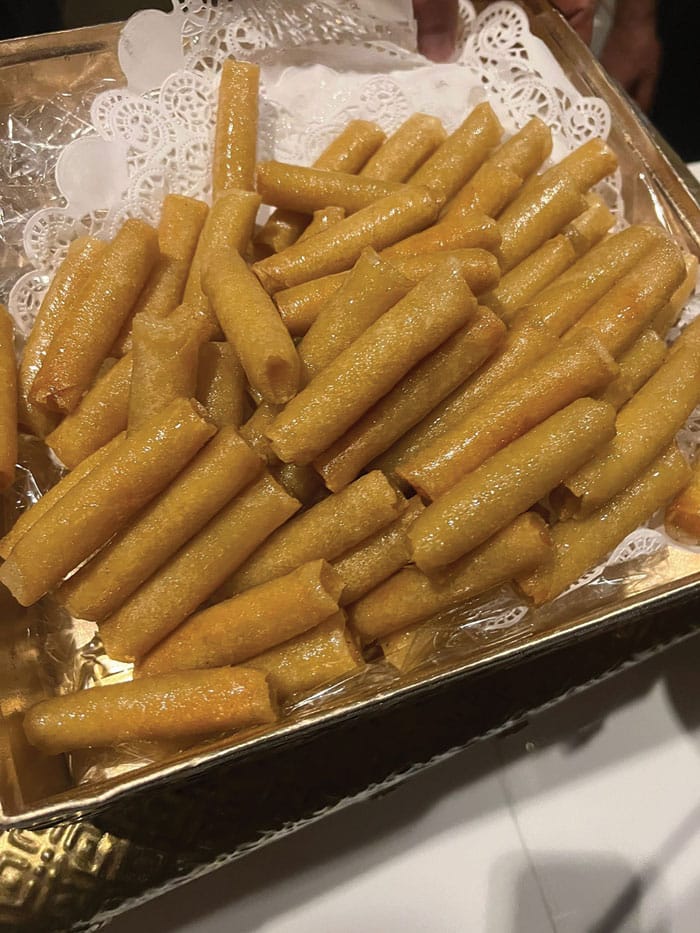
My Mother’s Almond Fingers
by Claudia Roden
These exquisite and delicate Arab pastries (Assabih bi Lozare family favorites. They feature in medieval manuscripts as lauzinaj, which were fried and sprinkled with syrup, rose water and chopped pistachios. In North Africa they are deep-fried but we have always baked them. You need the very fine filo sheets also called yuvka.
Makes about 30
2 1/3 cup ground almonds
1/2 cup superfine sugar, or to taste
3 Tbsp orange blossom water
1/2 lb phyllo pastry sheets
3 oz unsalted butter, melted
Confectioners’ sugar, to sprinkle on
Mix the ground almonds with sugar and orange blossom water.
Cut the sheets of phyllo into four rectangular strips about 12 x 4 inches (the size of sheets varies so it is not possible to be precise) and pile them on top of each other so that they do not dry out. Brush the top one lightly with melted butter.
Put one heaped teaspoon of the almond mixture at one of the short ends of each rectangle, or take a small lump and press it in to a little sausage in your hand. Roll up into a small cigar shape, folding the longer sides slightly over the filling midway.
Place on a buttered baking tray and bake in a preheated 325°F oven for 30 minutes, or until lightly golden.
Serve cold, sprinkled with icing sugar.
Variations:
• Other delicious fillings are ground pistachios flavoured in the same way with sugar and orange blossom water or chopped walnuts mixed with sugar and a tablespoon of ground cinnamon or the grated zest of an orange.
• Instead of baking them, you may deep-fry the pastries in not very hot oil and for only a very short time, until lightly colored. Drain on absorbent paper and dust with confectioners’ sugar. Serve hot or cold.
Sharon Gomperts and Rachel Emquies Sheff have been friends since high school. The Sephardic Spice Girls project has grown from their collaboration on events for the Sephardic Educational Center in Jerusalem. Follow them on Instagram @sephardicspicegirls and on Facebook at Sephardic Spice SEC Food.
